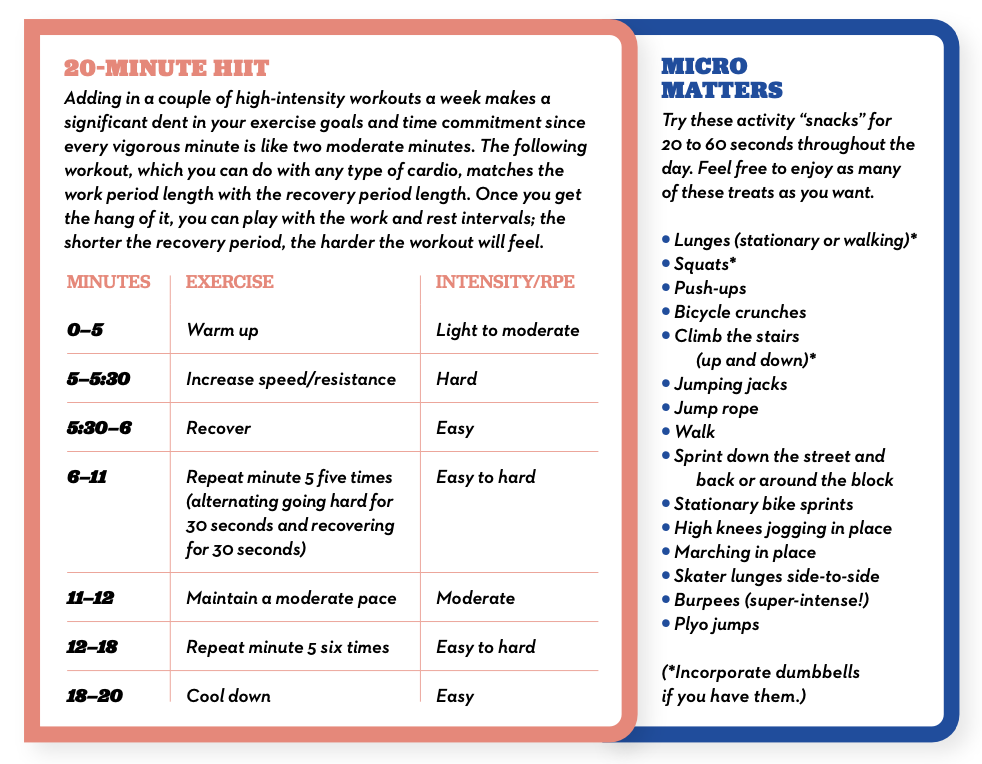Create an Exercise Routine That Works for You — And Counteract Inflammation and Other Diseases in the Process
Exercise is medicine.

You may have heard the phrase “exercise is medicine.” It’s some of the best medicine, in fact. In addition to providing that dopamine and serotonin-induced high, it helps reduce the risk of any number of chronic conditions, including heart disease, diabetes, certain cancers, fatty liver disease, dementia, depression, and more. It can also help mitigate the severity of these diseases and potentially reduce the need for some medications. And it slows the aging clock, keeping you feeling vital and strong — mentally and physically — well into your senior years. Exercise may accomplish all these feats in part because it helps reduce inflammation.
Research published in the journal Aging and Disease has shown that it does this in a few ways: By reducing the accumulation of fat that can creep on with age (fat lights a blowtorch under inflammation), stimulating the parasympathetic nervous system, and triggering the release of your body’s natural anti-inflammatory compounds.
The Exercise-Inflammation Connection
The conundrum is that exercise is also a potential inflammation trigger. Raising your heart
and respiration rate increases inflammation temporarily, which then subsides. According to a 2020 review, published in Frontiers in Physiology, exercise has a significant impact on inflammatory markers. High-intensity exercise with reduced recovery periods (think: daily hard-core cycling classes) and repeated ultra-long bouts of endurance exercise (running a few hours a day for many days) create a persistent increase in inflammation. Moderate exercise doesn’t appear to negatively increase inflammation. That’s not to say you should stay away from those long jogs or HIIT (high-intensity interval training) workouts; just pace yourself. Aim for no more than two or three HIIT bouts a week and pay attention to your recovery, which may be the most important aspect of any consistent fitness routine. A few tip-offs that you may be overdoing it: Your resting heart rate is higher in the morning, you’re having trouble sleeping, and you’re getting sick more often.
“Exercise is really important,” says cardiologist Monica Aggarwal, MD, co-author of Body on Fire: How Inflammation Triggers Chronic Illness and the Tools We Have to Fight It. “Not everyone can do a high load of exercise and everyone’s goal should be different. Just move as much as you can. You don’t need to run if you haven’t walked. If you overdo it, some of the things you’re doing can become inflammatory.”
Wrist Watcher
If you’re craving some feedback on your healthy habits, the WHOOP wearable can help. It’s a sleek wrist monitor that collects your data and sends it to an app, which provides feedback. The app gathers info during the day, telling you how much stress you put on yourself (whether through exercise or anxiety), how well you slept (it will wake you up at the best time based on your needs and rhythms), your body temp, and resting heart rate. It uses that data to calculate a Recovery Score every day, showing if you’re pushing yourself too hard.
The latest version, WHOOP 4.0, also tracks your blood oxygen levels and skin temps, which can help tip you off that you’re getting sick. Finally, the monitor will provide detailed performance assessments so you can identify those areas where you need improvement or are nailing it.
If you’re looking for a prompt to stand every hour or to beat your step PR, you won’t get it here. It’s focused on a deeper level of self-care versus activity. The WHOOP wearable itself is free but you have to use it with a $20-to $30-per-month app subscription — which is how you get all the metrics.
How Much Is Enough?
If you’re currently sedentary, any kind of activity is better than nothing and will have a positive impact on your health. You don’t have to tackle a big hike or take up running, but those activities that make your heart work a little harder will improve your fitness and that’s where the sweet spot is.
The World Health Organization recommends getting at least 150 minutes of aerobic exercise each week, which is 30 minutes on most days (more is better). If you work out at a vigorous level — those high-intensity workouts — you can cut that amount in half. But even if you don’t have that much time, you can still help your heart. One recent study found that just four seconds of hard work at a time can make a difference in metabolic markers.
Do What Works for You
The whole work-rest approach in general — a.k.a. HIIT — is a great way to shorten your workouts without reducing the benefits. Vigorous exercise puts extra (good) stress on your heart and also trains it to recover quickly. It improves how your body metabolizes fat and sugar and some research has shown high-intensity exercise targets that fat around your midsection (a.k.a. visceral fat), which is highly inflammatory. Again, you just don’t want to overdo it by making every workout vigorous.
“Any type of activity is better than nothing,” says certified personal trainer Anthony Wall, senior director of global business development at the American Council on Exercise in San Diego. “Ten minutes per day will give you more benefit than just a few minutes, but it’s not a magic number. It’s about creating frequency and volume. Even if what you’re doing isn’t very high intensity, those minutes do add up, like making deposits into your savings account.”
Pump Up

In addition to cardio exercise, you should also do at least two strength training workouts a week. While strength training does cause temporary inflammation in the muscles themselves, due to the fibers being broken down and then repaired (that’s how you build muscle and get stronger), it’s beneficial in the long run. A 2017 study in Frontiers in Physiology found weight training helps balance the anti-inflammatory response and counteract the process of immunosenescence, age-related declines in immune system functioning.
Your main goal when you’re strength training: Try to hit each area of your body — legs, hips/ glutes, abs, back, chest, and arms — at least once a week, and aim for one to three sets of 10 to 12 reps, using a weight that’s somewhat challenging to lift by your final rep. You can even combine your strength moves with cardio exercises for a dual aerobic-plus-strength hit, or just do your strength moves back-to-back for that double whammy (and time-saving) effect.
Light Your Spark
Even seasoned exercisers sometimes have trouble getting motivated to move, especially when it’s so easy to binge your favorite show on a cloudy, lazy afternoon. These tips can help you get over the inertia “hump.”
- Adjust Your Expectations: The biggest hurdle is overcoming the idea of what your “workout” needs to be to see a benefit. It’s not all or nothing. You don’t have to sweat it out on the elliptical for 45 minutes to notch a session. Recent research has shown that even “micro” workouts can help boost fat metabolism and improve fitness levels (calorie burn, not so much). What counts? Just 30 seconds to a minute of high-intensity exercise or strength moves (say, squats, lunges, walking stairs, or push-ups), repeated several times.
- Find an Activity That Resonates With You: The square-peg-round-hole saying applies in fitness, too. If you hate running, don’t run. Love the energy you feel from other people? Sign up for classes or other group workouts.
- Recruit a Friend: Whether you hate working out alone or just want someone to hold you accountable, exercise — like walking, dancing, kayaking, or skiing — is often more fun with someone else.
- Track Your Stats: You can log your steps, calories burned, heart rate, hours active, sleep, and more — all on your wrist. Some research has shown that having this kind of feedback helps people stick with their exercise program.
A version of this article appeared in our partner magazine, The Complete Guide to Anti-Inflammation.












